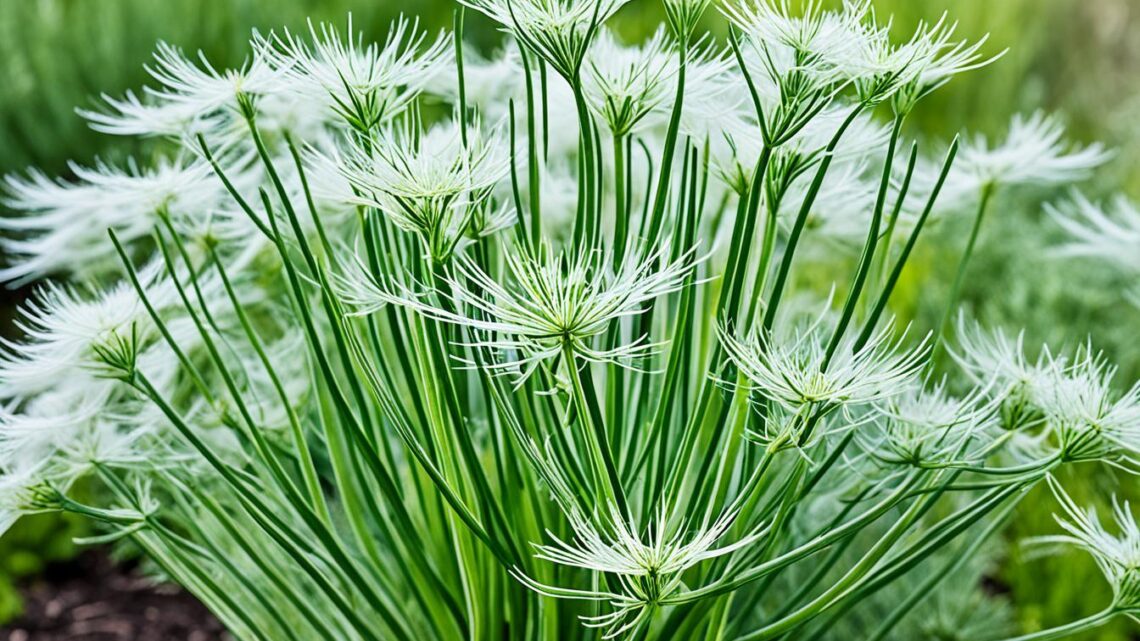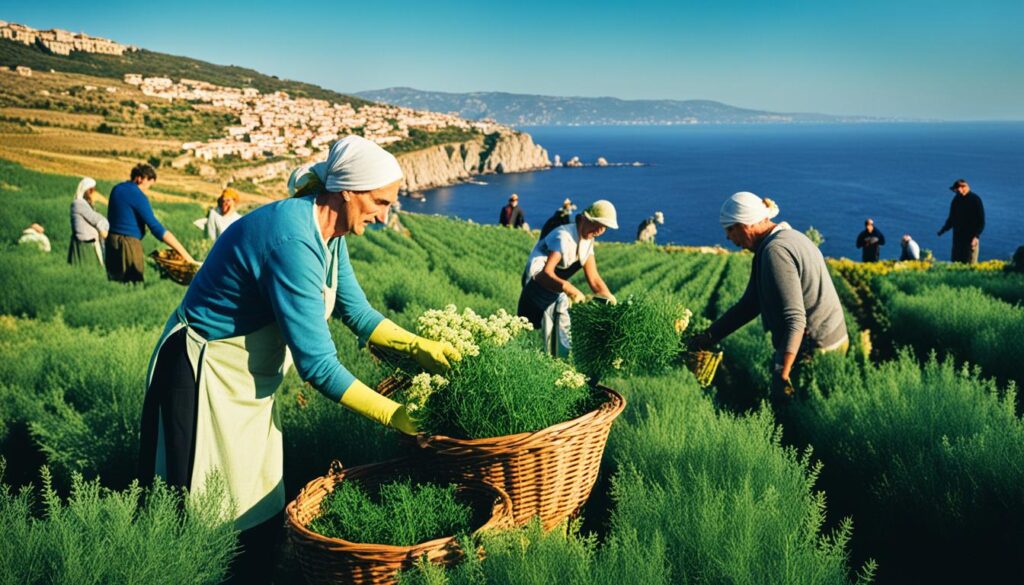
Have you ever thought about the amazing flavors and health perks of fennel? This herb belongs to the carrot family and is a staple in Mediterranean cooking. It has a sweet, earthy taste that makes dishes special. But what makes fennel more than just tasty? Does it really help with health and wellness?
Origins and History of Fennel
Fennel, known as Foeniculum vulgare, is a versatile herb with deep Mediterranean roots. It has been used in cooking and medicine for centuries. Its origins trace back to the Mediterranean shores.
Fennel’s Mediterranean Roots
Fennel started in the Mediterranean basin, where it was used since ancient times. Its unique flavor and health benefits made it a key ingredient in Greek, Italian, and other Mediterranean foods. Ancient people also used it for medicine.
Global Spread of Fennel Cultivation
Now, fennel is grown and eaten all over the world, including Europe, Asia, and North America. India is the biggest producer, making about 60% of the world’s fennel as of 2014. China, Bulgaria, Iran, Mexico, and Syria are also big producers.
Fennel is loved worldwide for its use in food and medicine. Its adaptability and health benefits make it a key part of many cultures.

| Top Fennel Producing Countries (2014) | Production (tonnes) |
|---|---|
| India | 582,000 |
| China | 150,000 |
| Bulgaria | 80,000 |
| Iran | 60,000 |
| Mexico | 30,000 |
| Syria | 25,000 |
Distinctive Flavor Profile of Fennel
Fennel is known for its unique and captivating flavor. Its bulbous base, feathery fronds, and aromatic seeds make it special. The taste is often sweet and licorice-like. This comes from a compound called anethole, also found in anise.
Sweet and Licorice-Like Taste
Fresh fennel has a mild anise flavor that’s perfect for many people. The bulb and stalks are sweet, while the seeds are more intense. This makes fennel great for many dishes, from salads to stews.
Fennel vs. Anise: Similarities and Differences
Fennel and anise both have a licorice-like flavor, but they’re not the same. Fennel tastes milder and sweeter than anise’s strong licorice flavor. They also look different, with fennel having feathery fronds and a bulbous base, and anise having thin leaves and slender stems.
| Characteristic | Fennel | Anise |
|---|---|---|
| Flavor | Sweet, mild licorice-like flavor | Stronger, more pungent licorice-like flavor |
| Appearance | Bulbous base, feathery fronds | Thin, wispy leaves, slender stems |
| Culinary Uses | Versatile, used in salads, soups, stews | Often used in baked goods, liqueurs, and teas |

Nutritional Value and Health Benefits of Fennel
Fennel is a versatile and nutritious vegetable. It has many health benefits. It’s full of vitamins, minerals, and antioxidants.
Rich in Antioxidants and Nutrients
A 234-gram raw fennel bulb is packed with nutrients. It has 360 mg of potassium, 45 mg of sodium, and 838 IU of vitamin A. It also has 43 mg of calcium, 10.4 mg of vitamin C, 0.64 mg of iron, 0.041 mg of vitamin B-6, and 15 mg of magnesium.
Fennel is full of antioxidants like rosmarinic acid, chlorogenic acid, quercetin, and apigenin. These can fight cell damage and lower the risk of chronic diseases.
Potential Benefits for Digestion and Women’s Health
Fennel’s fiber and minerals like magnesium, potassium, and calcium help with digestion. Studies show it can reduce bloating and help with irritable bowel syndrome symptoms.
It may also ease menstrual cramps by lowering prostaglandin levels. Fennel’s estrogen-like properties can help with breast milk production and menopause symptoms.
The antioxidants and nutrients in fennel support the immune system, heart health, and skin health. Fennel is great for a healthy diet because of its many uses in cooking.

Fennel
Fennel is a versatile herb that brings many benefits to the kitchen and health. It has a unique taste like licorice and is loved in Mediterranean cooking. Now, it’s popular all over the world.
Every part of the fennel plant is useful. You can use the bulb, fronds, and seeds in different dishes. Roast the bulbs, sauté them, or add them raw to salads. Use the fronds and seeds in soups, sauces, and baked goods.
| Fennel Statistic | Value |
|---|---|
| Fennel is one of Italy’s most popular vegetables. | – |
| Fennel recipe calls for 2 large fennel bulbs with stalk and fronds attached. | – |
| Fennel can be refrigerated in separate airtight containers for up to 1 day. | – |
| The recipe involves using 3 tablespoons of olive oil. | – |
| The sauce includes 1 3/4 cups of white wine. | – |
| The dish requires 2 tablespoons of drained capers. | – |
| The recipe uses 3 tablespoons of unsalted butter. | – |
| The cooking method involves caramelizing the fennel bulbs. | – |
Fennel is also known for its health benefits. It’s full of antioxidants and nutrients. These can help with digestion, reduce inflammation, and more. Adding fennel to your meals can be tasty and good for you.
Cooking with Fennel: Versatile Applications
Fennel is a versatile herb used in many dishes. You can use the bulb, stalks, and fronds. These parts add flavor to soups, salads, and main courses. Its sweet taste goes well with sweet and savory foods.
Using Fennel Bulbs, Stalks, and Fronds
The fennel bulb is often used for its crunchy texture and flavor. Stalks are great for stews and braises. The fronds are perfect for garnishing or adding to salads.
Fennel can be enjoyed raw, roasted, sautéed, or braised. This makes it easy to add to many dishes.
Fennel in Soups, Salads, and Main Dishes
Fennel is a favorite in soups like bouillabaisse and oyster stew. It adds a sweet flavor. In salads, it adds a refreshing crunch with citrus and greens.
In main dishes, fennel is great with pork shoulder or in pasta with swordfish. It fits well with many cuisines and cooking methods.
Fennel is in season from October to April. This gives cooks a chance to use it in many recipes. Fennel adds a unique flavor and crunch to dishes.
Fennel Tea and Essential Oil
Fennel is not just for cooking. It also has great benefits as a tea or essential oil. Fennel tea comes from the plant’s seeds. It’s known for easing digestive troubles.
Soothing Fennel Tea for Digestion
Fennel tea helps with bloating, gas, and indigestion. It has compounds like anethole and limonene. These help relax the digestive muscles for better digestion and nutrient use.
To make fennel tea, steep a teaspoon of seeds in hot water for 5-7 minutes. It’s great for those with irritable bowel syndrome (IBS) or other digestive issues.
| Nutrient | Amount per Teaspoon of Fennel Seeds |
|---|---|
| Calories | 7 |
| Protein | 0 grams |
| Fat | 0 grams |
| Carbohydrates | 1 gram |
| Fiber | 1 gram |
| Sugar | 0 grams |
Fennel essential oil comes from the seeds too. It’s a strong version of the herb. You can use it to flavor food, support women’s health, or ease inflammation.
Choose between fennel tea or essential oil for your health. This herb is great for self-care and wellness. Learn more about fennel medicinal uses to improve your health.
Growing and Storing Fennel
Fennel is easy to grow in your garden or on a bigger scale. It likes soil that drains well and lots of sunlight. You can start it from seeds or move seedlings outside. With the right care, you’ll get lots of fresh fennel all season.
Cultivating Fennel Plants
To grow fennel, plant seeds directly in the ground or start them indoors and move them outside. It takes about 10-12 weeks for a small bulb. Harvest from late June to October. Make sure the soil drains well and your plants get enough sun.
Proper Storage for Fresh Fennel
After picking your fennel, store it right to keep it tasty and fresh. Wrap the bulbs, stalks, and leaves in damp paper towels and keep them in the fridge for 10 days. Or, you can freeze fennel after blanching it. This keeps it good for 6 months, but it might change a bit in texture and taste.



